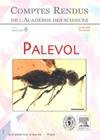1762年Meles Brisson属第一颗下臼齿的二维几何形态测量,包括来自下更新世Quibas遗址(西班牙穆尔西亚)的新獾证据
IF 1.3
4区 地球科学
Q3 PALEONTOLOGY
引用次数: 0
摘要
獾属于Meles Brisson属,1762年,包括四个现存物种(M. anakuma Temminck, 1844年,M. leucurus (Hodgson, 1847年),M. canescens Blanford, 1875年和M. Meles (Linnaeus, 1758年))。该属属于1838年的Melinae Bonaparte亚科,该亚科是欧亚鼬科的一个多系群,其进化关系有待进一步澄清。属的进化关系是复杂的,远未解决。这项工作旨在描述来自塞拉德基巴斯(穆尔西亚)的近1 Ma未发表的獾下颌骨,并帮助澄清欧亚獾的进化模式。为此,我们使用二维几何形态测量技术测量了79个Meles第一下磨牙(m1)的57个地标和半地标,范围从更新世到现存物种。我们的研究结果为区分原始獾和现存獾提供了证据。Quibas遗址发现的Meles的新m1比其他欧亚灭绝物种更纤细(相对较窄和较长),表明该标本可以被归入M. Meles Meles亚种(Linnaeus, 1758)。我们的研究结果还表明,M. meles atavus Kormos, 1914作为一个具有原始形态的相关亚种的命名在形态学上得到了支持。因此,我们得出结论,大约在1 Ma左右,在伊比利亚半岛南部已经分化出了现存的獾亚种M. meles meles,但在伊比利亚半岛北部仍然存在一些原始的残余种群,我们认为这是M. meles atavus亚种。本文章由计算机程序翻译,如有差异,请以英文原文为准。
2D Geometric morphometrics of the first lower molar of the genus Meles Brisson, 1762 including new badger evidence from the Lower Pleistocene Quibas site (Murcia, Spain)
Badgers belong to the genus Meles Brisson, 1762, which comprise four extant species (M. anakuma Temminck, 1844, M. leucurus (Hodgson, 1847), M. canescens Blanford, 1875, and M. meles (Linnaeus, 1758)). The genus is included in the subfamily Melinae Bonaparte, 1838, a polyphyletic group of Eurasian mustelids whose evolutionary relationships need further clarification. The evolutive relationships of the genus are complex and far from being resolved. This work aims to describe a nearly 1 Ma unpublished badger mandible from the Sierra de Quibas (Murcia) and to help clarify the evolutionary patterns of Euroasiatic badgers. To this end, we used 2D geometric morphometric techniques to measure 57 landmarks and semilandmarks in 79 first lower molars (m1) of Meles, ranging from Pleistocene to extant species. Our results show evidence for differentiating between primitive badgers and living species of Meles. The new m1 of Meles from the Quibas site is more gracile (relatively narrower and longer) than the other Eurasian extinct species, and shows that this specimen can be placed in the subspecies M. meles meles (Linnaeus, 1758). Our results also show that the denomination of M. meles atavus Kormos, 1914 as a related subspecies with a primitive morphology is morphologically supported. Therefore, we conclude that the living subspecies of badger M. meles meles was already differentiated in the south of the Iberian Peninsula at around 1 Ma, but some primitive remnant populations persisted in the north of the Iberian Peninsula, for which we recognize the subspecies M. meles atavus.
求助全文
通过发布文献求助,成功后即可免费获取论文全文。
去求助
来源期刊

Comptes Rendus Palevol
地学-古生物学
CiteScore
2.10
自引率
0.00%
发文量
39
审稿时长
17.6 weeks
期刊介绍:
Comptes Rendus Palevol is a fully electronic and peer-reviewed journal, with a continuous publication stream, devoted to palaeontology, prehistory and evolutionary sciences. It publishes original research results, in French or English, in the following domains: systematic and human palaeontology, prehistory, evolutionary biology and macroevolution, and history of sciences. Thematic issues may also be published under the responsibility of a guest editor. All articles published in Comptes Rendus Palevol are compliant with the different nomenclatural codes. A copyright assignment will be signed by the authors before publication.
 求助内容:
求助内容: 应助结果提醒方式:
应助结果提醒方式:


